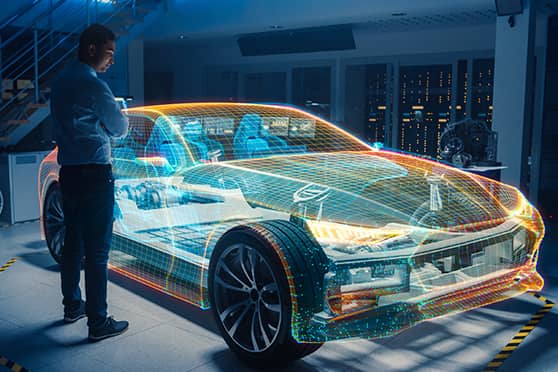The Role of AI in Automotive Engineering: Revolutionizing the Road Ahead
Artificial Intelligence (AI) has permeated countless industries, but its transformative impact on automotive engineering is particularly noteworthy. From enhancing safety features to optimizing manufacturing processes, AI is reshaping how vehicles are designed, produced, and experienced. In this blog, we delve into the multifaceted role of AI in automotive engineering and explore its far-reaching implications for the future of driving.
1. Autonomous Driving: The Pinnacle of AI Innovation
One of the most discussed applications of AI in automotive engineering is autonomous driving. Self-driving cars leverage a combination of AI techniques, including machine learning, computer vision, and sensor fusion, to navigate roads with minimal human intervention. AI algorithms process data from cameras, LiDAR, radar, and other sensors to understand the vehicle’s environment, make real-time decisions, and ensure safe driving.
Companies like Tesla, Waymo, and Cruise are at the forefront of this technology, continually refining their AI systems to handle complex driving scenarios. The ultimate goal is to achieve full Level 5 autonomy, where vehicles can operate without any human input, promising safer roads and more efficient transportation.
2. Enhanced Safety Features: AI as a Guardian
AI’s role in enhancing vehicle safety is becoming increasingly sophisticated. Advanced Driver Assistance Systems (ADAS), powered by AI, include features such as adaptive cruise control, lane-keeping assist, automatic emergency braking, and collision avoidance. These systems use AI to analyze sensor data, detect potential hazards, and respond proactively to avoid accidents.
For example, AI-driven predictive analytics can anticipate maintenance needs by analyzing vehicle data, thus preventing breakdowns before they occur. AI’s ability to process vast amounts of data in real-time also enables more accurate and responsive safety features, significantly reducing the likelihood of human error.
3. Predictive Maintenance: AI for Longevity
Predictive maintenance is another area where AI is making a significant impact. Traditional maintenance schedules are often based on time intervals or mileage, which may not always align with the actual wear and tear on a vehicle. AI, on the other hand, uses data from various sensors to monitor the condition of critical components in real-time.
By analyzing patterns and anomalies, AI can predict when a part is likely to fail or require maintenance. This not only extends the lifespan of vehicle components but also enhances overall vehicle reliability and reduces unexpected breakdowns, leading to a more efficient and cost-effective ownership experience.
Effective SEO for the automotive industry involves optimizing content with targeted keywords, enhancing local search visibility, and leveraging industry-specific data to drive more qualified leads and boost online presence.
4. Optimizing Manufacturing Processes: AI in Production
In automotive manufacturing, AI is streamlining production processes and improving efficiency. Machine learning algorithms analyze production data to optimize workflows, reduce waste, and enhance quality control. AI-driven robots and automation systems are increasingly used for tasks such as assembly, painting, and inspection, leading to higher precision and consistency in manufacturing.
AI also plays a role in supply chain management, where it helps forecast demand, manage inventory, and optimize logistics. By integrating AI into manufacturing operations, automotive companies can respond more quickly to market changes and improve overall production efficiency.
5. Personalized In-Car Experience: AI as a Co-Driver
AI is transforming the in-car experience by offering personalized features that enhance driver comfort and convenience. Natural language processing (NLP) enables voice-activated controls, allowing drivers to interact with their vehicle’s infotainment system, navigation, and communication features without taking their hands off the wheel.
Additionally, AI-powered systems can learn driver preferences over time, adjusting settings such as seat position, climate control, and entertainment options to suit individual tastes. This level of personalization not only improves the driving experience but also contributes to a more intuitive and user-friendly interface.
6. AI in Vehicle Design: Innovating for the Future
The design process in automotive engineering is also benefiting from AI. Generative design algorithms use AI to explore a vast array of design possibilities and identify optimal solutions based on parameters like weight, strength, and material efficiency. This approach allows engineers to create innovative and more efficient vehicle structures and components.
Furthermore, AI assists in crash simulations and safety testing, providing valuable insights into how different design elements perform under various conditions. By leveraging AI in the design phase, automotive engineers can develop vehicles that are not only more innovative but also safer and more efficient.
Conclusion: Embracing the AI Revolution
The integration of AI into automotive engineering is ushering in a new era of innovation, safety, and efficiency. From autonomous driving to predictive maintenance, AI is driving advancements that promise to revolutionize the way we experience and interact with vehicles. As technology continues to evolve, we can expect AI to play an even more significant role in shaping the future of transportation.
As we embrace the AI revolution, it’s essential to consider both the opportunities and challenges it presents. While AI has the potential to enhance safety and efficiency, it also raises questions about ethics, privacy, and the future of work in the automotive industry. Navigating these challenges will be crucial as we move toward a future where AI and automotive engineering work hand in hand to create a safer, smarter, and more connected world on the road.



